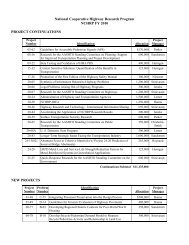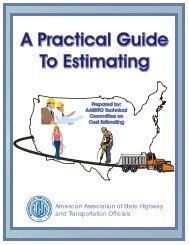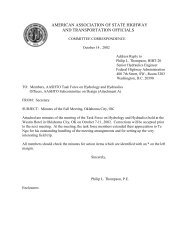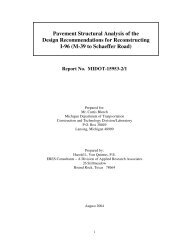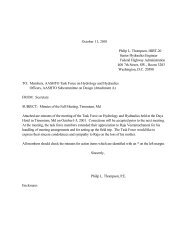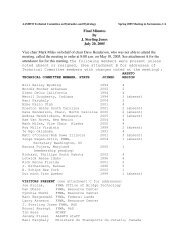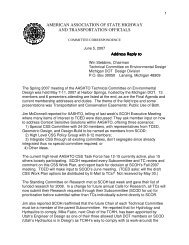Summary of AgileAssets findings on potential use of PMS for ...
Summary of AgileAssets findings on potential use of PMS for ...
Summary of AgileAssets findings on potential use of PMS for ...
You also want an ePaper? Increase the reach of your titles
YUMPU automatically turns print PDFs into web optimized ePapers that Google loves.
Each state will need to undertake some research associated with the guides. This may<br />
range from in-ho<strong>use</strong> familiarizati<strong>on</strong> studies to follow up studies with FHWA, materials<br />
calibrati<strong>on</strong> studies at the state university or full fledged major research ef<strong>for</strong>ts with a<br />
c<strong>on</strong>sultant. One thing that each state should c<strong>on</strong>sider is the <strong>use</strong> <str<strong>on</strong>g>of</str<strong>on</strong>g> an expert team to go<br />
through the list <str<strong>on</strong>g>of</str<strong>on</strong>g> extensive input variables as a group to try to establish the hierarchical<br />
importance <str<strong>on</strong>g>of</str<strong>on</strong>g> each variable. For example Poiss<strong>on</strong>’s ratio is an input requirement <strong>for</strong><br />
the guide <strong>for</strong> certain pavement types. It is a well known fact that the Poiss<strong>on</strong>’s ratio can<br />
vary widely yet <strong>on</strong>ly has a minimal effect <strong>on</strong> the calculated stresses and strains.<br />
There<strong>for</strong>e, the expert team might choose to set Poiss<strong>on</strong>’s ratio at a fixed 0.4 rather than<br />
spend m<strong>on</strong>ey and energy <strong>on</strong> further refinements. On the other hand, the modulus <str<strong>on</strong>g>of</str<strong>on</strong>g><br />
elasticity <str<strong>on</strong>g>of</str<strong>on</strong>g> important pavement layers has a major effect <strong>on</strong> pavement stress and<br />
strain. There<strong>for</strong>e, ef<strong>for</strong>ts are needed to measure the complex modulus or to find an<br />
effective way <str<strong>on</strong>g>of</str<strong>on</strong>g> determining it in the laboratory <strong>for</strong> design. It is estimated that this<br />
approach <str<strong>on</strong>g>of</str<strong>on</strong>g> classifying critical variable could result in categorizing the 150 input<br />
variables into three groups. About a third <str<strong>on</strong>g>of</str<strong>on</strong>g> the variables could be fixed such as (Level<br />
3) Poiss<strong>on</strong>’s ratio. Another third could be obtained through correlati<strong>on</strong> or expert<br />
estimates (Level 2) leaving perhaps 25 to 30% which require detailed measurement and<br />
input into the process <strong>for</strong> improved design (Level 1).<br />
It is clear from visits and discussi<strong>on</strong>s with eight states that a state DOT can undertake<br />
the <strong>use</strong> <str<strong>on</strong>g>of</str<strong>on</strong>g> their pavement management system data to calibrate the new MEPDG <strong>on</strong> a<br />
l<strong>on</strong>g-term basis. It is equally clear that the development <str<strong>on</strong>g>of</str<strong>on</strong>g> a Satellite <strong>PMS</strong>/Pavement<br />
Design Database <strong>use</strong>d <strong>for</strong> a l<strong>on</strong>g-term calibrati<strong>on</strong> will also provide needed electr<strong>on</strong>ic<br />
storage <strong>for</strong> design data inputs <strong>use</strong>d in designing new projects with the guide and thus<br />
provide a mechanism <strong>for</strong> effective storage <str<strong>on</strong>g>of</str<strong>on</strong>g> that data which has not be<strong>for</strong>e been<br />
available.<br />
A Final Report entitled Using Pavement Management Data to Calibrate and Validate the<br />
New MEPDG, an Eight State Study,” Final Report, Volumes I and II, FHWA C<strong>on</strong>tract<br />
DTFH 61-05-C-00011, September 30, 2006, by W. R. Huds<strong>on</strong>, P. Visser, C. M<strong>on</strong>ismith,<br />
C. Dougan.<br />
Prior reports cover the <strong>use</strong> <str<strong>on</strong>g>of</str<strong>on</strong>g> <strong>PMS</strong> data to validate Superpave per<strong>for</strong>mance as follows:<br />
“Use <str<strong>on</strong>g>of</str<strong>on</strong>g> <strong>PMS</strong> Data <strong>for</strong> Per<strong>for</strong>mance M<strong>on</strong>itoring with Superpave as an Example,” Final<br />
Report, Federal Highway Administrati<strong>on</strong>, C<strong>on</strong>tract DTFH61-98-C-00075, B98C75-007,<br />
Battelle Subc<strong>on</strong>tract 156421, March 20, 2002, W. R. Huds<strong>on</strong>, C. L. M<strong>on</strong>ismith, C.E.<br />
Dougan, and W. Visser.<br />
“Evaluating Superpave Using Per<strong>for</strong>mance, Materials, and C<strong>on</strong>structi<strong>on</strong> Data <strong>for</strong> Task<br />
Order 34,” Final Report, Federal Highway Administrati<strong>on</strong>, C<strong>on</strong>tract DTFH61-98-C-<br />
00075, Battelle Subc<strong>on</strong>tract 180686, November 30, 2004, W. R. Huds<strong>on</strong>, C. L.<br />
M<strong>on</strong>ismith, C.E. Dougan, and W. Visser.<br />
“Method <str<strong>on</strong>g>of</str<strong>on</strong>g> Evaluating the Per<strong>for</strong>mance <str<strong>on</strong>g>of</str<strong>on</strong>g> Superpave using the Pavement Management<br />
Database” Submitted to Battelle, Task Order Proposal Request #34,<br />
C<strong>on</strong>tract No. DTFH61-98-C-00075, November 2004.<br />
1/8/08 <str<strong>on</strong>g>Summary</str<strong>on</strong>g> 6




